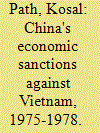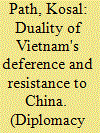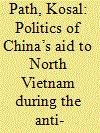| Srl | Item |
| 1 |
ID:
116492


|
|
|
|
|
| Publication |
2012.
|
| Summary/Abstract |
This article carries a two-fold argument. First, Beijing's economic sanctions against Vietnam during the period 1975-1978 were mainly motivated by its desire to punish Vietnam for an anti-China policy that smacked of ingratitude for the latter's past assistance, fuelled further by Hanoi's closer relations with Moscow. They were also designed to extract Hanoi's accommodation of China's demand for territorial boundary concessions and to halt the persecution of ethnic Chinese residents in Vietnam. Second, the resultant meltdown of Sino-Vietnamese relations, as well as the making of the Soviet-Vietnamese alliance between 1975 and 1978, was gradual and contentious rather than swift and decisive as most existing studies contend. Hanoi's reluctance to forge a formal military alliance with the faraway Soviet Union against China was largely driven by the importance of China's remaining aid and economic potential to Vietnam's post-war economic reconstruction and the uncertainty of the Soviet commitment to aid Vietnam.
|
|
|
|
|
|
|
|
|
|
|
|
|
|
|
|
| 2 |
ID:
161044


|
|
|
|
|
| Summary/Abstract |
Critically reviewing David Kang’s China-centred hierarchical model, his interpretation of historical interactions between China and Vietnam favours Sinocentrism whilst claiming to rescue historical East Asian international relations theories from Eurocentrism. This analysis provides a nuanced account of Vietnam’s agency in pursuing its national interests in the context of a rising China, showing that Vietnam today continues to draw on the historical tradition of deference/resistance to China to orient its strategies and tactics in dealing with its northern neighbour. Vietnam’s stance toward China is akin to balancing Great Power influence, which entails enlisting other Great Powers to defend its core interests vis-à-vis China. The result is that Vietnam simultaneously pursues a mixture of deference and resistance to China that does not resemble balance of power—against China, or balance of threat—bandwagon with China's behaviours.
|
|
|
|
|
|
|
|
|
|
|
|
|
|
|
|
| 3 |
ID:
150078


|
|
|
|
|
| Summary/Abstract |
Behind the public display of Sino–North Vietnamese unity in the anti-American resistance during the height of the People’s Republic of China’s Cultural Revolution from 1965 to 1969, Beijing’s insistence on Hanoi’s acceptance of Maoist ideology coupled with its assertive demand for Hanoi to denounce Soviet revisionism politicised its economic and technical assistance to North Vietnam. Although appreciating Beijing’s enthusiasm to aid North Vietnam, the Democratic Republic of Vietnam [DRV] resented Beijing’s political and ideological objective of promoting Maoism and anti-Soviet revisionism in North Vietnam. In response, the DRV government asserted independent decision-making and bureaucratic control over the management of foreign economic and technical aid, which in turn collided with the Chinese assertion of superiority and insistence on their control over all China-aided projects. The fragmentation of Chinese bureaucratic institutions and the political chauvinism of some radical Maoists at the Chinese Embassy in Hanoi, who oversaw Chinese aid to North Vietnam, further hindered Beijing’s ability to exert significant influence over Hanoi.
|
|
|
|
|
|
|
|
|
|
|
|
|
|
|
|